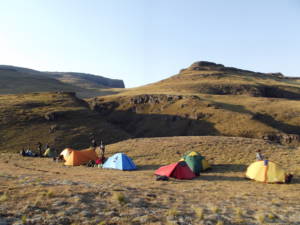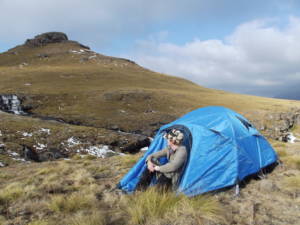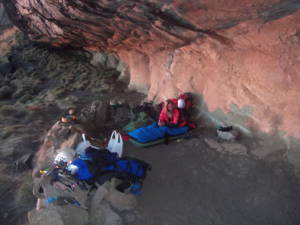There are no absolute rules on where and how things must be done when selecting a campsite or cave. There are, however, many different things to consider prior to selecting one. The choice may also be determined by other factors such as having to stop due to a problem with someone in the party or that a sudden storm is about to hit.
When planning a hiking trip, try to estimate how far each day’s journey will be and then on the map identify some possible places to stay. If using a cave, try to gather some prior knowledge about it, especially its size, how much shelter it offers and its exact location. Remember that a good cave offers very good shelter (better than any tent), does not have to be dried out in the morning, will not blow away and saves the extra weight of having to carry a tent.
Campsite selection
When choosing a camp site you need to consider the following:
- It should be within a hundred or so meters of fresh water.
- It should not, however, be in the riverbed.
- It must be out of the flash flood level – summer storms.
- It must be out of the wind.
- It must not be on top of a high point – lightning in summer.
- The ground must not be too rocky or hard.
Cave selection
Selecting a good cave has similar criteria to a tented campsite. Consider also which way the cave actually faces and which way the wind is likely to blow from. A cave with a high roof (one in which one can stand) is always more comfortable than a low roofed one. Please note that some caves tend to drip water through the roof, especially in summer. Also remember that if a cave shows signs of dripping that if a big rainstorm is approaching these drips are likely to increase, maybe to the extent of making the area unlivable. It is important to remember that on some Drakensberg maps, caves are not marked in their exact locations. When looking for a known cave, keep a lookout for cairns in the area, which will lead you to the exact spot. The deeper the cave the more likely it will give good shelter and if it has a wall of rocks built up in front of it, it shows that it is frequently used by others, which probably shows that it’s a good cave. By cutting grass and placing it on the floor, the comfort of a cave can be greatly enhanced, as the grass makes a softer sleeping area and keeps down the dust.
Camp Hygiene
The places where you will be camping are pristine wilderness areas and should remain so after you have left the area. No litter whatsoever must be left behind. All rubbish such as tins and plastic must be carried out. Never use soap directly in the fresh water. If hands or pots need to be washed take water from the stream. Wash the items at least 30m away and rinse in the same place. This means that the soap filled water is allowed to run into the soil and be broken down before entering the stream system. This same process stands when cleaning teeth. If possible also use biodegradable soaps, which are available in outdoor shops.
If you are wanting to wash your body with soap also wash and rinse well away from the running water. It is acceptable to simply swim in the river, but make sure it is down stream of where the party will be collecting water. Try not to swim if you have any newly put on sun-cream, as this also pollutes the water.
Toilet arrangements
In a group situation at a campsite or cave the leader needs to identify a “toilet area” where everyone can “go” during the stay. If needing to urinate, move at least 30 meters from the stream in an area where there is no sign of water in the soil (i.e. not a swampy area). All feces should be buried at least 30 centimeters underground. Please make sure this is well away from water or any ground water. Toilet paper, sanitary pads and tampons should also be buried deep in the ground. Carry a small trowel for digging. Note that if in a remote area, far from well-used caves or paths, there is another method of disposing of feces. This is called the smear and burn method. Here simply smear the feces on an open rock so that the sunlight breaks it down quickly. The toilet paper is then burned off, leaving very little trace within a day or two. Use this method only in areas where there is no chance of causing a run-away fire. Be especially careful of long dry grass in winter.



